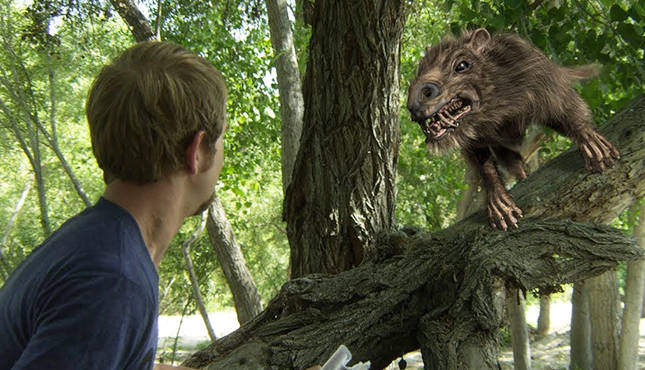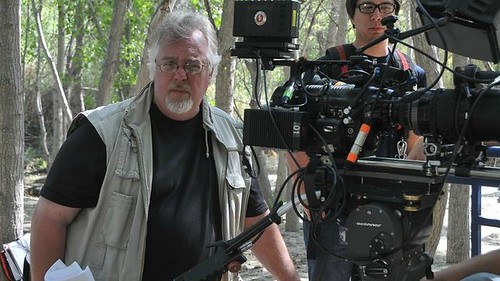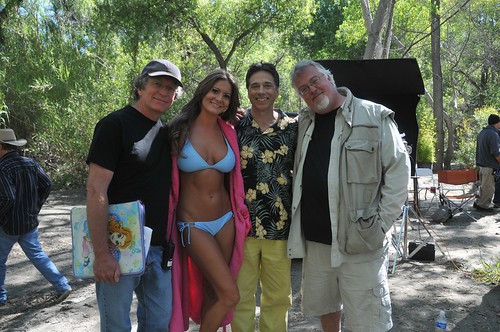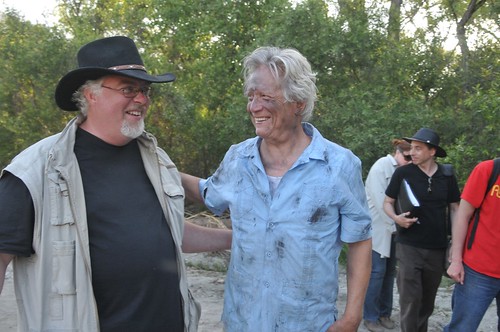Movies & TV / Columns
Director Steve Latshaw Talks w/411 About His Latest Film, Return of the Killer Shrews

The 411 Interview: Steve Latshaw
Steve Latshaw is a writer, producer, and director who has been making movies since the very early 1990’s. He has directed eight movies to date and written the screenplays for around thirty and has worked with people like Fred Olen Ray, Jim Wynorski, Dolph Lundgren, and Stan Lee, among others. Latshaw’s latest release is the mega belated sequel Return of the Killer Shrews, starring James Best, John Schneider, and Bruce Davison, which is set to debut on ITunes on October 26th (check out my review here). In this interview, Latshaw talks with this writer about making Return of the Killer Shrews, his career in the movie business, and more.
**
Bryan Kristopowitz: How did you get involved with Return of the Killer Shrews?
Steve Latshaw: I involved myself in 1989 after interviewing James Best at his acting school in Orlando, Florida, for a news story I was doing. At the time, I was starting to do some TV news reporting on the Florida film industry for NBC affiliate WESH TV. After Jimmie and I became friends, I pestered him about the idea and finally wore him down.
BK: Were you a fan of the original The Killer Shrews before you got involved with the sequel?
SL: Yes. I originally read about it in The Golden Turkey Awards. When I moved from the small town of Carbondale, Illinois in 1987 to the Orlando, Florida area in 1987, I discovered Blockbuster Video (we didn’t have one in Carbondale.) The Winter Park Blockbuster contained all the schlock drive-in movies I’d wanted to see. Killer Shrews was right there and I rented it, expecting to see the goofy, horrifically bad and hysterically funny movie the Medved brothers had blathered about in their book. What I discovered was that it was not a bad film. It was a tight, tense, nifty little thriller, dark in tone and quite scary. I was hooked.
BK: Where was Return of the Killer Shrews filmed?
SL: One day at Marina Del Ray for the boat landing sequences and the ocean sequences. Two days at Bronson Canyon for the quarry and cave scenes. Seven days at Sanna Ranch outside of Agua Dulce, CA, for the jungle and compound sequences. This was all in early June, 2011. We also did one day of inserts and pickups in Eagle Rock, CA, in July.
BK: How did you cast Return of the Killer Shrews?
SL: Some parts were recommendations from people we have worked with. Jason Shane Scott came highly recommended from Dave DeCoteau and was an excellent choice. Jeneta St. Clair and Katherine Randolph came from Dan Golden and were top notch, with impeccable comic timing. We knew we wanted John Schneider and Rick Hurst; both were happy to work with Jimmie. I met with two other name actors for Jerry before we were lucky enough to land Bruce Davison. Chris Goodman came at the recommendation of Michael and Janeen Damian and he was wonderful. I had a particular idea for the character of the Director but Chris had his own spin – a wonderful interpretation that caused me to toss my own character notes out the window and go with his choices. David Browning was recommended by Jimmie, who’d worked with him and loved him. Jimmie was right, as always. David is an extraordinarily gifted performer, as is his wonderful wife Patty, who did her lines in one perfect take. Jennifer Lyons is part of the extended Best family. She’s smart, funny and beautiful. The part of Mickey was a departure for her… tough, serious, a real action hero. She was so good we wrote a new scene on the spot for her and David Browning, where they discuss her on again/off again relationship with the character played by Jason Shane Scott. Maggie Wagner plays John Schneider’s agent in the film. I’d known her for years – and knew how good she was. The rest of the cast came from a casting call Dorothy Best and I held down in Hollywood. Rory Flynn recommended her son Sean Flynn (Errol Flynn’s grandson). So I had to cast him – and he’s very talented. And Pat Moran had to be in it. That was a no brainer. He’s a tremendous actor who always gets stuck behind the scenes writing and producing.
BK: How long did it take to make Return of the Killer Shrews, from finishing the script to completing post-production?
SL: The first draft script was completed in the summer of 2010. I came to North Carolina to work on the script that fall with Pat and Jimmie. Revisions continued into the new year and right up to the first shooting day. Dan Golden completed a final budget in early 2011. Financing was set by April. We shot in June, first cut completed by early July, inserts and pickups in July, and then about six months of CGI work by Silo Inc. Sean Hart, one of the producers, runs that effects company. Sean also put together the financing. We premiered the film on March 5, 2012.
BK: What was the hardest part of making Return of the Killer Shrews?
SL: My previous features had been shot on film. This was my first film using the RED HD system. In the old days, to save film, I’d cut if something wasn’t working. Line Producer Dan Golden, who was doubling as 1st AD, had to keep reminding me not to cut, just keep rolling and reset. Don’t cut and shut everything down. It’s just X’s and 0’s. There’s no film stock to worry about saving, lol. I quickly got used to it.
BK: Were the Killer Shrews always going to be majority CGI for Return, or were other options proposed early on that just weren’t feasible? Would it have been possible to do the Shrews like in the original, essentially a dog with a costume on?
SL: We never entertained the idea of using dogs or real animals. I’ve worked with animals and it can be time consuming and expensive on a film like this. We had limited time and budget. Originally, the shrews were going to be CGI scarab-like creatures who consume their victims like land piranha. But at a certain point we decided – CGI or not – that the creatures needed to resemble the shrews from the first film. We did have a practical shrew built by Jeff Farley as well. The snake was not intended to be CGI. We actually had a long prop snake. But the prop was awful… unconvincing… the head didn’t match the body. So, on the spur of the moment I re-blocked the scene and shot it for CGI, with background plates. Our CGI was marginal, but as this film is a comedy and a send-up of bad CGI Creature Features, it all worked out just fine.
BK: Why has it taken six years for Return of the Killer Shrews to appear on Video On Demand? What sort of DVD release did it originally have?
SL: Our original distributor, American World Pictures, marketed the film as a straight horror film. It’s not. It’s a comedy. In one scene it features Sean Flynn in a goat suit, for Pete’s sake. We begged them to sell it as the comedy it was. They patted us on the shoulder and said, “We know best, pal.” So the key art and trailer and campaign was – you guessed it – straight horror. We had warned them that anyone who saw this film expecting a straight horror film was going to be decidedly annoyed when they saw it. And they were. AWP sold a few small overseas territories for DVD only and no TV sales except for Benelux. They were unable to get a domestic sale. On our own, with their permission, we quickly secured a domestic DVD deal with Fred Olen Ray’s Retromedia. Fred packaged a wonderful DVD set with lots of extras and released it in the fall of 2013. That sold OK among monster fans. A small but respectable run. It’s now out of print. We got the rights back from AWP after 18 months. We realized that we still owned most of the world…. no TV sales, no VOD, streaming, etc. We knew if we could market the film successfully, promote the film as the comedy spoof it was always meant to be, that it would find its audience. We decided to sit on the film until the market was ready. The new distribution model called Aggregation came into play and we met a distribution expert named Sean Flanagan who “got” the film and knew the best way to market it. He loved our original, “retro” key art, which sold it as a retro cult film and we were off to the races. Marketing and branding is critical. An unusual film like this has to be sold as the hidden gem it is. Return of the Killer Shrews had such a limited release that, for most viewers, this is a brand new movie.
BK:What was it like working with James Best both in terms of writing the screenplay and as an actor?
SL: I’ve never worked with a better actor than James Best. His depth of knowledge when it came to camera technique alone was staggering. Once, a director asked him if he could cry on cue. He said, “How long and which eye?” As a writer, I worked with Jimmie for 26 years. We spent 15 years tossing around ideas for Shrews. We had just finished writing a Twilight Zone-style 30 minute script based on a Civil War poem he’d written when Jimmie passed. I’d love to make it one day. The funny thing about Jimmie, when you’d send him a scene – or pitch him an idea for a scene, if he didn’t like it he’d say “I don’t understand.” That was your cue to go back to the drawing board. Having said that, he was always fun and full of energy. He could be exhausting. He’d pound out thirty pages in record time and send them out. Wrote great, funny dialog. “I’ll slap you to sleep and slap you for sleeping!”
BK: Did you always plan to do the sort of Dukes of Hazzard reunion with James Best, John Schneider, and Rick Hurst?
SL: We wanted them together because they were fine actors and had great chemistry. The little Dukes reunion scene was something I’d written for fun. I ran it past Jimmie and Dorothy and they liked it. John and Rick liked it and ran with it. We kept a little bit of it in the film but the three of them riffed on it for about three minutes. We have the outtakes.
BK: How has the B-movie world changed since you got started back in the early 1990’s?
SL: It’s now buyer driven. It used to be, you’d come up with commercial ideas, pitch them and pre-sell them at film markets and then make the films. Pre-sales at this level don’t happen much anymore. Now, buyers come to producers looking for something specific… a Christmas movie… or a Hallmark Romcom that’s also a Christmas movie. Or a Lifetime movie. I read an article about The Asylum a couple of years back. They make a movie with a submarine battling an underwater dinosaur and another movie with a giant shark. Both do well in Japan. Japan says, “This time we want a movie with a submarine and an underwater dinosaur AND a giant shark. Can you have it ready in three months?” That’s how it works now. They tell you what they want. Films frequently don’t get made until they’ve already got a buyer waiting. Budgets are much lower as well.
BK: According to imdb there’s a fourteen year gap between your directing Death Mask in 1998 and Return of the Killer Shrews in 2012. Why such a long gap?
SL: Death Mask was actually shot in 1995 and completed in 1996. I moved to Hollywood in 1995. At the time, I had a good reputation for being able to deliver a high quality, commercial feature film on a short schedule for $100,000 or less. I had a hit movie (Jack-O) in video stores. But by the time I got to Hollywood the video boom was waning and there was no longer a demand for features at that level, unless they were late night, soft core Cinemax stuff, and I wasn’t interested Also, I had more value as a director when based in Florida. Big fish, small pond, with Florida providing new locations and production values and cheaper production costs. By moving out to LA, I became irrelevant. In the fall of 1996, Fred Ray – who’d financed three of our Florida films – offered me a gig writing a family film called Invisible Dad. It was done for Andrew Stevens’ company Royal Oaks. After that, Andrew hired me to write the Jeff Speakman adventure film Scorpio One, and I was off to the races. From 1996 to 2012 I was working pretty regularly as a screenwriter. In 1999 alone I wrote 9 films, all of which were produced.
BK: What was it like working with Dolph Lundgren on Command Performance?
SL: No short answer for this. Dolph is smart, funny, generous and a talented writer and director. I originally met him in 2000 when I wrote – un-credited – additional scenes for an action film he’d done called Agent Red. I met him again through Andrew Stevens, when I was asked to help rewrite his film Missionary Man. I read the script, gave him my notes and told him he’d be wasting his money hiring me. The script was almost there. He didn’t need me. A year later we met in LA. He gave me three treatments and asked me to pick which one I wanted to do with him. I read three very detailed screen stories and picked Command Performance. We worked on the script together for about a year. I did a draft, then he did a draft, back and forth until we got it where we wanted. It was a great experience.
BK: You’ve worked with such B-movie luminaries over the years as Jim Wynorski, Fred Olen Ray, and Christopher Olen Ray. What was it like working with them on their movies?
SL: Wynorski loved matching his new actors and props to stock shot sequences. He is a master at it. If he’d been working back in the late 40s and early 50s when Republic Pictures was building their later serials around stock sequences, he’d have been the go-to guy. Jim is a writer himself, and very detail-oriented. He’s a guy that will give you very specific notes on individual sentences and words in the dialog.
Fred Olen Ray has been my employer, my mentor and friend for 28 years. He gave me my start in the business, gave me a second one when I found myself out here and not working and continues to provide advice and support. I am a proud attendee of the Fred Olen Ray School of Filmmaking. Not a graduate. You never graduate from that school. You always continue to learn. I don’t know anyone who knows more about this business than he does. Fred’s thing is that “you also have to make a good movie.” He always tries to bring something extra to the table. We did a submarine movie once with Michael Dudikoff called Counter Measures. It was the usual Royal Oaks military hardware film with a subplot involving a secret Russian sub, terrorists and a missing nuclear weapon. Fred wanted more production value and cooked up a scheme to get actual footage of actors in Moscow by working out a plan with Gary Graver to shoot his wife Jillian Kesner at the Kremlin while they were attending a film festival. These movies always end with “the fistfight to save the world” and Fred wanted Dudikoff to mix it up with the heavy on top of the submarine… surfaced… at night… and in a storm. So he moved actors and a small crew and a wind and rain machine to San Francisco and shot on the deck of a real sub. It’s those kinds of imaginative tricks that set his work apart. And he follows his own advice: you have to make a good movie.
I’ve known his son Chris since he was fifteen and came down to Florida to play the Biohazard monster for a day in Biohazard: The Alien Force. He’s a Navy vet and has become a fine director. I enjoyed writing Megaconda for him. The film was a good old fashioned monster movie shot on my favorite movie location, the Iverson Movie Ranch, in Chatsworth, CA.
BK: Who are your moviemaking heroes?
SL: In no particular order: John Ford, John Huston, Orson Welles, Roger Corman, Bill Grefe, Burt Kennedy, Andrew McLaglen, John Sturges, William Witney, Joseph Kane, Fred Sears, Budd Boetticher, Brian G. Hutton, Guy Hamilton, Terence Young, John Glen, Bernard Kowalski and Fred Olen Ray.
BK: Any upcoming projects you can tell us about?
SL: I am working with Pat Moran and Guillaume DeLouche (who started with us in the old days and now does exclusively big budget features) We are excited about our new project – a reboot of Jack-O. The original film was very popular when released, and has gone through three different releases on DVD… in 1998, 2004 and in 2016. The most recent incarnation on DVD was in a set of our early Florida films called JACK-O & FRIENDS – THE STEVE LATSHAW COLLECTION. That set sold out earlier this year and has now gone into a second pressing. Our new Jack-O is a 25 years later sequel – on a much larger budget than the first. It will focus in part on a new family but three characters (and the actors that played them) from the first film will feature prominently.
BK: Did Bruce Davison bring his own flute or is the flute he uses in the movie something that you had to supply?
SL: Gary Griffin, a talented musician who provided the songs for the movie performed by the Bamboo Trading Company and some incidental cues had a closet filled with flutes. We picked out a nice one for Bruce. I had them in my truck for a year before I remembered to give them back to Gary!
**
A very special thanks to Steve Latshaw for agreeing to participate in this interview and to david j. moore for setting it up.
Return of the Killer Shrews is set to arrive for the first time ever on Video on Demand on iTunes on October 26th, and will then hit Amazon and Google on November 9th.
Check out the Return of the Killer Shrews official website here, where you can still buy the movie on DVD.
Check out the Return of the Killer Shrews Facebook page here.
Check out Steve Latshaw on Twitter here.
Images courtesy of Steve Latshaw.












